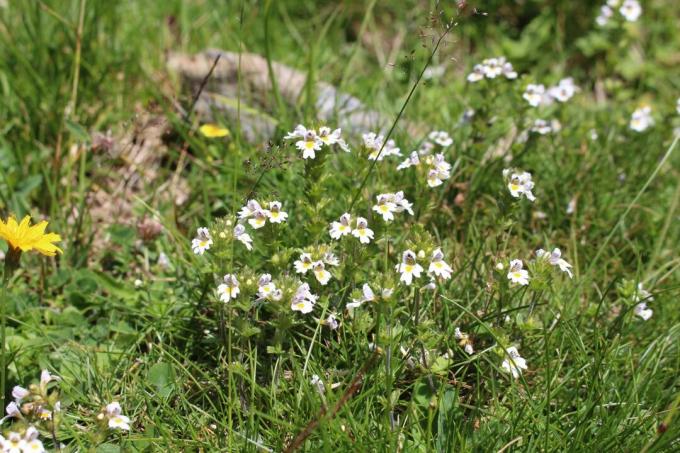Eyebright is an old medicinal plant that has become rare. It is traditionally used for eye problems. We show how you can plant eyebright in the garden if you pay attention to a few special features.

The Common Eyebright (Euphrasia officinalis) has long been used for healing products such as ointments and teas. The cultivation of the herb, which seems inconspicuous at first glance, poses a number of challenges and requires some background knowledge. We tell you what you should pay attention to when cultivating, harvesting and using eyebright.
The eyebright herb has already proven its worth as a medicinal plant for overtired eyes or mild inflammation of the conjunctiva. Nowadays, you will mainly find eyebright teas and ointments on the market.
contents
- Eyebright: flower, origin and properties
- Plant eyebright yourself
- The right care
- Harvesting and application of eyebright
Eyebright: flower, origin and properties
The eyebright - or eye herb - is a medicinal plant that is also native to Germany. The plant genus eyebright (
Euphrasia) belongs to the mint family (Lamiales) and occurs in almost the entire northern hemisphere. The plants grow wild in meadows and are admired in gardens as ornamental plants. Euphrasia officinalis Like many other species of the genus, it is on the Red List and is one of the endangered plants whose natural population is declining sharply.Eyebright is a herbaceous annual plant that grows up to 30 cm high. It belongs to the group of semi-parasitic plants that draw nutrients and water from other host plants with special roots, the haustoria. If Euphrasia plants don't find a host in the immediate vicinity, they are also able to draw water and nutrients from the soil. The leaves of the plants are small, elliptical in shape and strongly serrated. They are arranged crosswise on the stem and sit a short distance apart on the shoot. Eyebright flowers are typical lip flowers and about 1 cm in size with a white base color. There is a yellow spot on the lower lip of the flower and purple veins are often visible. The flowers appear between July and September and then form capsule fruits with seeds.

tip: Euphrasia officinalis is popularly known by many names. The more interesting synonyms include: Milchdieb, Wiesenwolf, Hungerblümli or Gibinix. All of these names suggest that eyebright decreases the yield of a pasture, thereby reducing the milk yields of the cows grazing on it.
Plant eyebright yourself
Eyebright seeds should be sown between October and December for best success. The point in time is crucial for a good germination rate, because the seeds need a longer period of cold temperatures below 5 °C to germinate. Since the eyebright is one of the semi-parasites, a host plant must be grown for cultivation. Sweet grasses are best suited as host plants. For the best success, the eyebright seeds are sown in an existing lawn. Find an area that will not be walked on and mark it, for example with bamboo sticks. Eyebright is a light germ. That means the seed should lie flat on the ground to get sunlight. If the lawn is too dense or too high, the grass should be cut and raked out with the lawnmower before sowing.
The soil should be nutrient-poor and loose so that the host plants thrive. In the case of very loamy and hard-trodden lawns, it can make sense to use sand or lawn soil. Our fine ones are suitable for this, for example Plantura lawn sand or our peat-reduced and loose ones Plantura organic lawn soil. Both are worked into the topsoil with a rake. When the area is prepared, the seeds can be spread and then lightly pressed down. Since the seeds first go through a dormant phase, there is no need to water them immediately after sowing. Now it's time to be patient: until the beginning of March of the following year there is hardly any visible change, because it is only at this point in time that the first eyebright plants begin to sprout.

Summary: Plant eyebright yourself
- Soil: poor in nutrients, loose
- Location: Mowed lawn area that is not walked on
- When: Late fall to early winter (October to December)
- Germination: Only after exposure to cold in spring, light germinates
The right care
The lawn should be kept short at the beginning of the year to provide the germinating seeds with enough light. It is best to cut the grass where eyebright grows with scissors to avoid damaging eyebright plants. Euphrasia species are generally well adapted to drought. The areas only need to be watered when the host plants show signs of drought stress. Fertilization is usually avoided, as this tends to reduce the growth of the eyebright. For a high harvest, the young side shoots should be cut back every two to four weeks in spring to encourage the growth of new side shoots.
Harvesting and application of eyebright
The optimal time for harvesting the eyebright herb is when about two thirds of all the flowers are fully open. When harvesting, cut off the entire herb just above the ground and place it in a shady, well-ventilated place to dry. The eyebright herb is best harvested on a sunny day and first dried briefly in the sun on newspaper and then left to lie in the shade. Depending on the amount and the weather, it can take a few hours to days to dry. When the herb is completely dry, it can be stored in an airtight container.
Since the 15th The herb of the plant has been used in medicine for centuries. As the name suggests, it was mainly used for eye problems. Nowadays, eyebright extracts, ointments and teas are used for the following complaints, among others:
- conjunctivitis
- inflammation in the eye
- barley grains
- dark circles
- Ulcers on the cornea

For this purpose, ointments are mainly used. But eyebright also helps with indigestion and colds. It is prepared as a tea for this purpose. To prepare an eyebright tea, take a handful of eyebright herb and pour boiling water over it. After 5 to 10 minutes of steeping, the herb can be strained and the tea can be drunk.
Like the milk thief is the vermouth (Artemisia absinthium) in the lawn undesirable for some gardeners. But fresh or processed wormwood from your own garden works wonders, especially with digestive problems.
